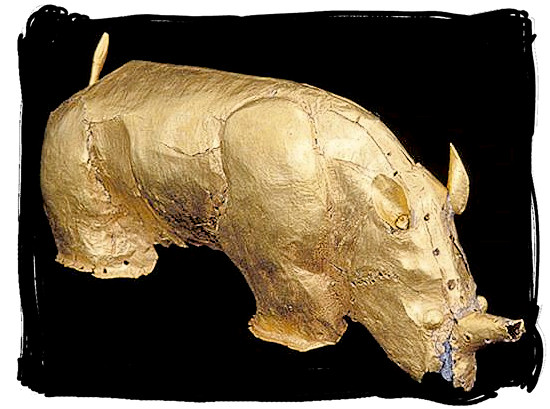A SOUTH AFRICA WORLD HERITAGE SITE
Set right up against the northern border of South Africa,
uniting Botswana and Zimbabwe, lies Mapungubwe National Park - an extensive
savannah landscape situated at the meeting place of the Limpopo and Shashe
rivers. This is the land of sandstone formations, mopane woodlands, brooding
baobabs, ancient floodplains and unique riverine forests that form a dramatic
backcloth for the wealth of animal life - elephant, giraffe, buffalo, white
rhino, gemsbok and other antelope, extensive bir life, and the more elusive
mammal like hyenas, leopards and lions.
Mapungubwe is South Africa’s first kingdom, a highly complex
society that marked the heart of a pre-Shona kingdom between 1050 AD and 1270
AD, only to be abandoned in the 14th century. The Mapungubwe Cultural Landscape
- the virtually untouched remains of the palace sites, the settlement area
dependent upon them, and two capital sites that remain - was declared a UNESCO
World Heritage Site in 2003 and forms part of the Mapungubwe National Park.
The Cultural Landscape provides visitors with a unique
portrait of the social and political structures of a society that traded with
China and India, was regarded as the most complex society in southern Africa
and was the first society since the Bushmen to settle in South Africa. The
kingdom was regarded as the forerunner of the Zimbabwe civilisation and at its
height, Mapungubwe, which means place of the stone of wisdom, was the largest
kingdom in the African sub-continent. Some 5000 people appeared to live around
Mapungubwe Hill where their ‘sacred’ leader lived in seclusion from his people.
After the collapse of Mapungubwe’s society, it was forgotten
until the wealth of artefacts on top of Mapungubwe Hill - a sandstone
oval-shaped hill with sheer vertical cliffs and a plateau of about 300 metres
known as the ‘place of jackals’, accessible only by means of two very steep and
narrow paths - were discovered.
Mapungubwe National Park: One of the country’s newest parks,
Mapungubwe opened to the public in September 2004. Not only does it provide the
public with an awesome window on the rich and varied animal life in this part
of South Africa, but it is a chance to explore Mapungubwe Mountain and the
culture that, despite being discovered in 1932, was kept largely hidden from
the public until recently. This discovery included three findings of
significance: a beautiful golden rhinoceros made from gold foil nailed around a
wooden interior, and a gold sceptre and bowl, all uncovered from the excavation
of twenty three graves on the hilltop site and which are on display at the
Mapungubwe Museum at the University of Pretoria.
THE GOLDEN RHINO
The rhino is thought to symbolise power because of its
ferocious temperament and is still a leadership symbol among the Shona of
Zimbabwe today. The little golden rhino is not only evidence of these peoples’
metalworking skills and trade with the East - the rhino has a single horn like
the Asian variety - but it also symbolises to the world that South Africa’s
cultural heritage is far richer and goes back further than realised.



No comments:
Post a Comment